The Magigical Mystery Of Mullet On The Fly
The Magical Mystery of Mullet on the Fly
Approximately 10 years ago whilst fishing for Sea Trout in the Lower Bann estuary close to where I live near Castlerock, Northern Ireland, I noticed very large shoals of Mullet cruising the margins as the tide filled. I tended to ignore these shoals of fish other than having the occasional throw with my sea trout patterns to no avail. Then on a number of days I made a point of walking the estuary as the tide filled, with no rod, solely to observe these shoals of Mullet as they had begun to intrigue me. I noticed that there were always a number of fish in front or to the rear of the main shoal. As the front runners moved up the shoreline in approximately 6 to 8 inches of water I noticed that there was a sprinkling effect on the surface, seconds before an eruption of fish broke through the surface, and this was discovered purely by chance as conditions were extremely hot with not even a whisper of a breeze on the estuary.
The Lower Bann Sands
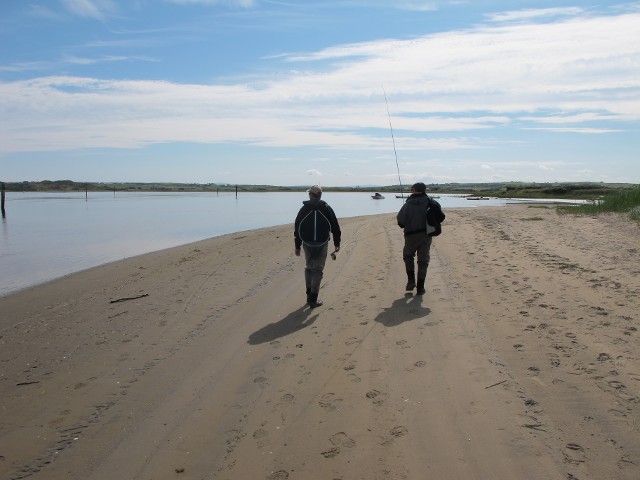
I returned home and put the old thinking cap on. Were they chasing sand eels or small fry? They were definitely chasing something! I went through all my boxes, found some sand eel patterns, threw them into a salmon fly box which had bits & pieces in it, grabbed a 9 weight rod which I use for Bass, got into the car and went back to the estuary. I walked up the shore, sand eel pattern on, fish approaching; cover front runner, Fish on ….Fish off! This happened a dozen times. I then kept cutting the sand eel pattern tail back, then the savage takes stopped. I was going off my head. Then for the hell of it, yes, in the salmon box was a size 16 currys red shrimp pattern, fly on!! Shoal approaching, front runners pushing stuff up, covered with the fly, long straight draw on line, Bang!!!! The rod practically wrenched from my hand, off it went and went and went, full fly line out through the top eye, backing screaming off the reel, blood flowing from my line finger, 80 yards of backing gone. The missile decides to turn and head back at me, and I’m running backwards to keep the tension on the fish. Eventually 15 minutes later a 6.5lb bar of silver grey power house into the net, size 16 currys red shrimp in the side of a car tyre lip -these fish do not have soft mouths as often heard amongst the angling fraternity, it is in the name, “Thick Lipped Grey Mullet”, think about it! The fish was returned to fight another day. I then sat down, shook for while and watched another pod moving towards me, then done exactly the same as before. BANG, similar fight, (so the 1st one was not a fluke) HAPPY DAYS!!! 5 mins later a 2lb Mullet. Time to change the fly, just to see! On goes a size 16 Bann Special, another 4 fish in the net. The last one I dispatched to eat and also to check the stomach contents. Yes, you guessed it, it was crammed full of sand shrimp!!! These were the little things sprinkling and fleeing the mighty Mullet.
Lower Bann Mullet
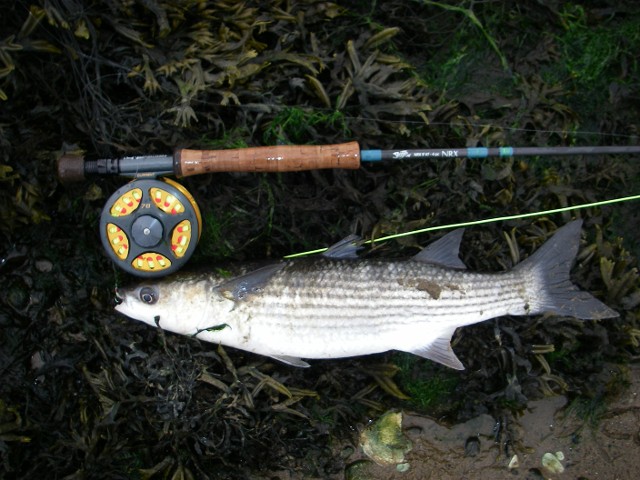
Prior to Release
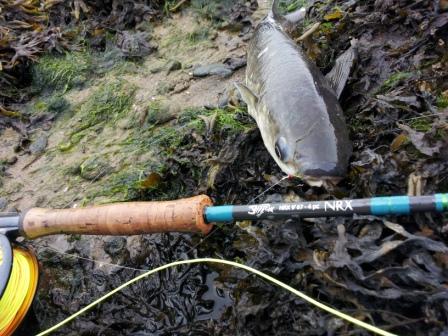
Since then I have had an obsession for Mullet on the fly, they are an absolutely beautiful fish, fantastic fighting and completely unpredictable once hooked. Thick Lipped Grey Mullet - Chelon labrosus - mature at around 4 to 6yrs, or over 30cm. A fish of 40cm is roughly 9yrs old, and a fish of 50cm is around 12yrs old.
Mullet in the Lower Bann Estuary tend to arrive into the system in mid April, it is all dependant on water temperature. Larger numbers appear as the temperature rises. Around mid October the shoals group together then migrate south to warmer water. A key factor to bear in mind when fly fishing for Mullet is wind direction, they always want to be in the lea off the wind, I guess it is down to minimal fluctuations in water temperature.
. 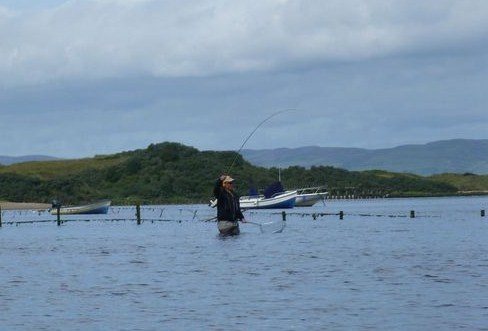 Fish On!!
Fish On!!
Since my initial findings which I have mentioned I have had the opportunity to study and analyse the habits of the Mullet which visit the lower Bann estuary, enabling me to fine tune and refine my tactics. Occasionally I will revert to the tactics which initially proved successful and reflect at what has turned into a complete passion for me. Fine tuning has generally been focused on the fish themselves by just watching them at different stages of the tide and different months over the season. From April to mid July I tend to stick to shrimp patterns then change to baitfish patterns. Yep, baitfish patterns! Purely by fluke around 4 years ago I was catching large numbers of Sea Trout on my normal bait fish patterns when Mullet started to hammer them cast after cast. The Mullet that I was landing had their mouths stuffed with what appeared to be juvenile Mullet and Pollack fry. The unusual thing was I didn’t have to strike at all they just ate the fly, hooked themselves and emptied the reel. The main changes I have made are with the fly patterns I may go down to a size 22 sparsely dressed shrimp pattern in calm hot weather up to a size 10 long shank bait fish pattern.

On the left the old & on the right the new
Over the past 3 years I have been using a G.Loomis NRX 9ft #7 balanced with a G.Loomis Crosscurrent 7/8 reel loaded with a WF 7# full floater which is an absolutely outstanding outfit for the environment, I generally use this outfit from April until Mid August when the larger fish start to show up. I then beef the rod up slightly to a G.Loomis Crosscurrent GLX 9ft #8 and 8# line. A Mullet from 5 pounds up will test your equipment to destruction. Leader material consists of 10 feet of 6, 8, 10 or 12lb Fluorocarbon depending on conditions and time of the year. Chop and change your retrieve, think what the sand shrimp does and how it moves. One more tip that will hopefully bring you success is once you feel anything at your line strike as hard as you can,try to break your rod, as if your life depended on it, you have to set the hook or else they are gone!.Once the hook is set let the fish run, if you lock up its gone.!!! My real adrenaline rush from these magnificent fish is when a number of Mullet are competing for the fly on a flat calm day. A number of bow waves come at you from every direction; it is completely indescribable the anticipation, then bang, Fish On!!!
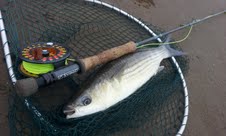

“ A Pair of Grey Ghosts”
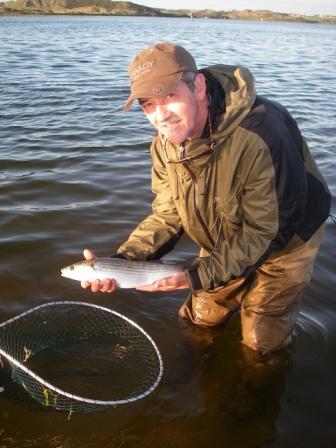
Unusually small Mullet from the
Lower Bann Estuary
As a result of my occupation I get to travel a lot and spend quite a bit of time in Florida, where I enjoy warm saltwater fly fishing from the beaches or sight fishing for Snook, Redfish and Tarpon. A few years back I had an opportunity to be hosted at Redfish Landings, Ruskin, Florida by Capt John Hand who is an exceptional fly fishing instructor and guide. Also in the company was fly fishing author and instructor Joe Mahler. My brief was that we were to sight fish for Snook and Red Fish on the Little Manatee River. To my surprise the 2 individuals had hatched a cunning plan the previous evening. Unbeknownst to me, instead of taking a skinny guy from Ireland to stalk Reds & Snook with the possibility of encountering a large Tarpon, at which I get extremely overwhelmed and excited about, they had arranged something else!! At breakfast Joe asked if I had any of my Mullet flies with me and like a fool I told him I had. “Ok” said John, “we’re going Mullet fishing!!” As much as I love Mullet, I can get them at home. Anyway the following events unfolded. I was placed into an 18ft skiff accompanied by the two instigators. At 9am we motored up river for 20 mins where I spotted a shoal of Mullet moving on the left bank. Armed with my G.Loomis NRX 9 #7 strung up with a dark shrimp pattern on the point, I took a shot at the stragglers to the rear of the shoal, delivering my fly close to the bank in about 10 feet of water. Strip, strip, strip thump, thump. My heart was in my mouth, happy days, I can now go and fish for Snook, but no, not a Mullet, but a highly prized Blue Gill. John and Joe were both elated that my flies actually worked. I pointed out to John the Mullet we encountered were moving fish which are hard to turn on. A few minutes passed and I observed a number of Mullet feeding in about 1 Foot of water on the right bank. John polled me into position, took a shot at a fish delivering about 3 to 4 inches in front of him, gently stripping the fly away from him. The fish turned and ate the fly as John and Joe looked on. Landed, the fish took a few photo’s and I released it. Joe exclaimed, “We all thought for a number of years that you were full of Mad Dog ---- and it only took you 28 mins from leaving the dock!”.
Needless to say on returning to the dock my fly box was relieved of its contents. Since then John & Joe have used them with continued success!!
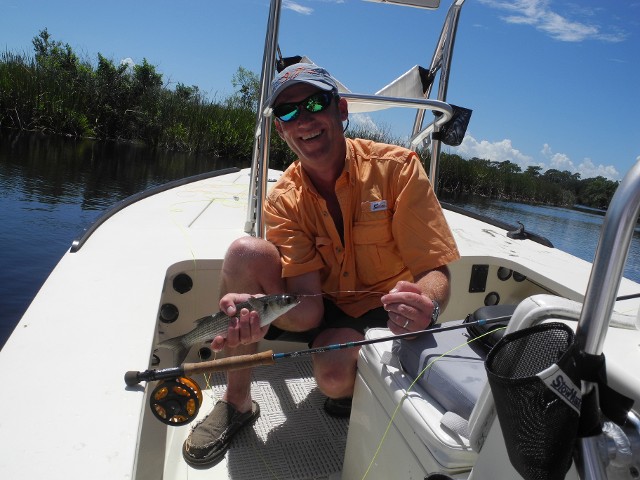
28 minute success
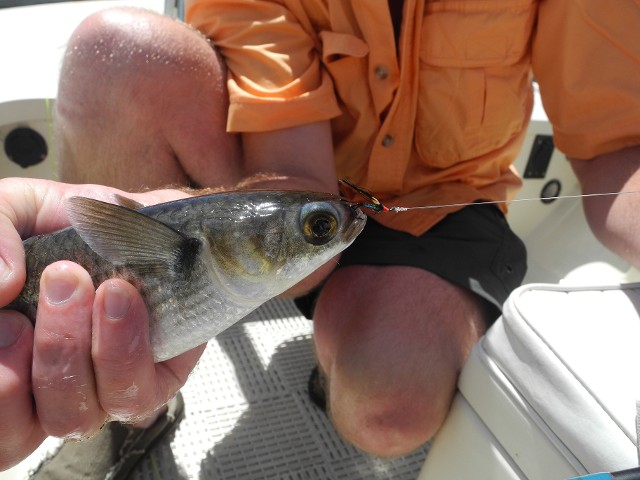
Absolutely Beautiful!!!
A word of caution, the Lower Bann estuary may look fairly safe and unassuming, but be wary of deep holes, submerged weed covered boulders and large areas of extremely sticky mud flats. Also take into account the tidal movements and the wake from boat traffic. I would advise the use of a professional angling guide at all times.
The Lower Bann estuary opens on 1st March and season closes on 31st October. Permits can be obtained from Bann Systems, Cutts House, 54 Castleroe Rd, Coleraine, or Smyths Country Sports, Park Street, Coleraine. A Department Of Culture, Arts & Leisure Rod Licence is also required and can be obtained from most tackle shops in the province.
The author Leslie Holmes is a G.Loomis Pro Guide. He owns and operates Stone Falls Trout Fishery and School of Fly Fishing.
He also runs Stone Falls Guiding services. He is a Federation Of Fly Fishers Master Casting Instructor & Two Handed Certified Instructor, and also hold A.P.G.A.I qualifications in both single and double handed disciplines.
As of January 2014 Leslie has relocated to Placida, South West Florida where he operates Leslie Holmes International School of Fly Fishing.